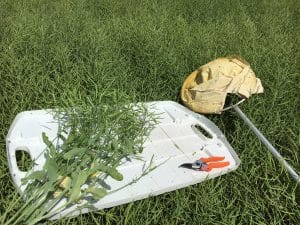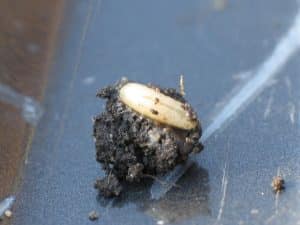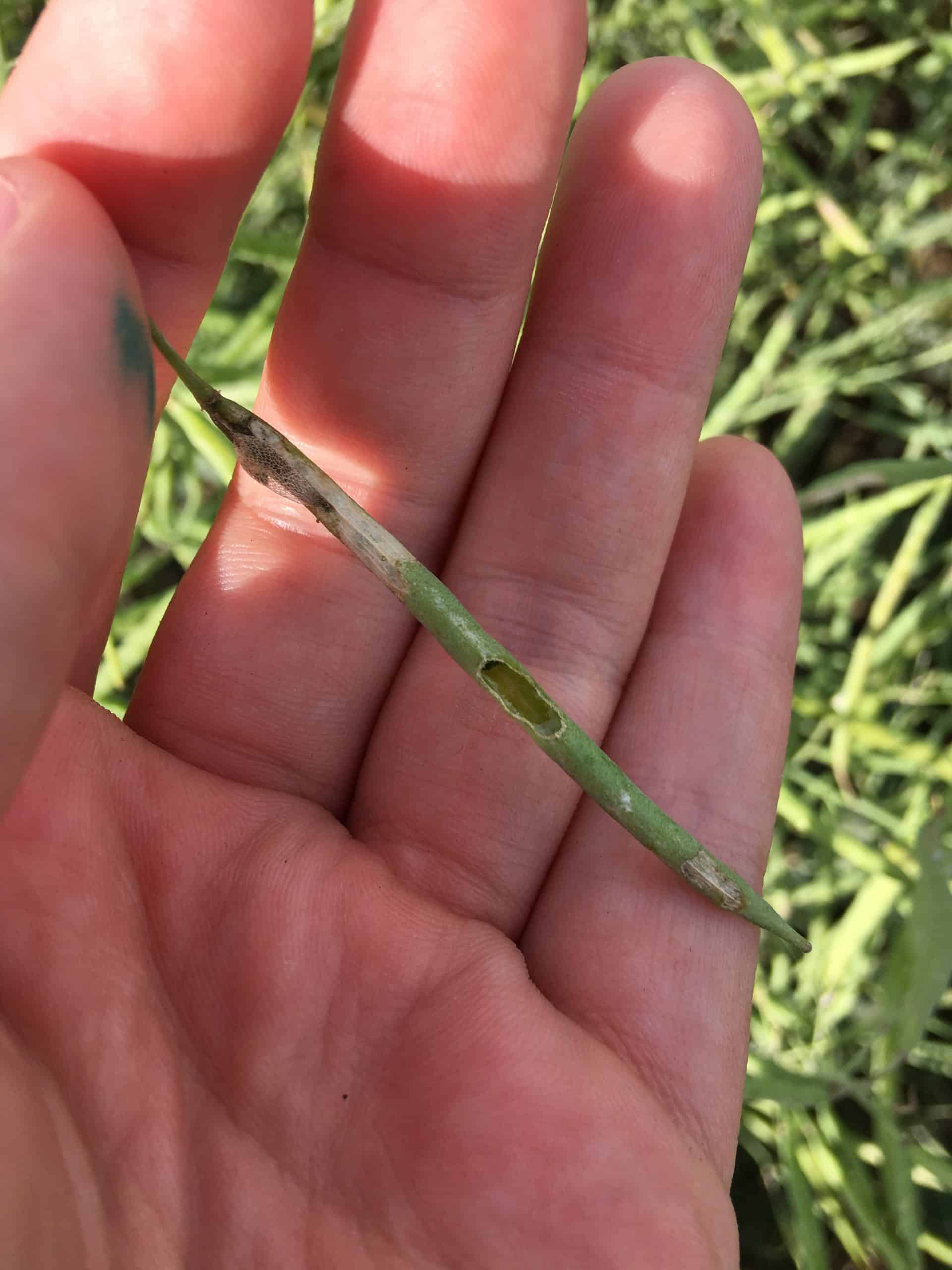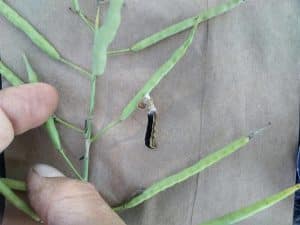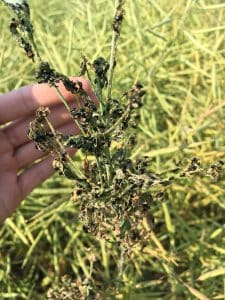While some areas aren’t reporting much insect activity, there are a few insect hot spots and some regions with insects close to threshold levels. When scouting your canola for insects, go out in early morning or late evening when larvae are mostly active, and try to sample at least five locations (although 10-15 is recommended) of each field. Look at each of these areas of the plant for these insects.
Check for root maggots.
- Pull up the plant to check for these larvae. They can cause premature ripening (similar to some diseases), so identifying the proper cause of it, can save you time and effort down the line. If the plant taproot breaks off slightly below the soil surface then root maggots are likely suspects. Look for maggots or tunneling. If the plant is girdled at or slightly above the soil surface, and taproots are not tunneled by root maggots, then a disease is more likely. No insecticides are registered or provide an economic benefit on root maggots. Crop rotation can provide effective management when numbers are high enough to cause yield loss. Maggot damage is often higher with low plant populations. Root maggot damage can increase the amount of root rot damage.
Above ground plant surface, including leaves, stems and pods, depending on the plant stage and the amount of green material available. Check for diamondback moth larvae, bertha armyworm and flea beetles.
Diamondback moth larvae
- Diamondback moth (DBM) larvae are pale yellowish-green to green and covered with fine, scattered, erect hairs (that you’d need a hand lens to see). The posterior end of the caterpillar is forked, which is easy to see with the naked eye. At maturity, larvae are cigar-shaped or spindle-shaped (narrower at each end) and about 12mm (0.5″) long.
- First instars are very small (~1mm) and feed between leaf surfaces. You will often find all sizes present. When disturbed, larvae will wriggle backward violently and may drop from the plant, suspended by a silken thread.
- As canola leaves senesce, diamondback larvae usually move up to the pods. Checking for leaf feeding is a good first clue of this insect’s presence in the field. Feeding on the exterior of the developing pods is responsible for their “economic” pest status. The nominal threshold for diamondback moth larvae is 200-300 larvae per square metre (20-30 per square foot) in plants with flowers and pods. Plants under moisture stress and with very little leaf surface may be more likely to suffer yield loss, so the lower threshold number could be used in this situation.
- As pods start to harden off, the damage will shift to the younger top pods.
- Recent rain showers in some areas may have knocked the larvae off plants (and potentially left them to be eaten by predatory beetles), so recheck DBM larvae numbers if this is the case for you.
- In between generations (when DBM pupate, changing from a larva to an adult moth) the population will appear to drop. Be sure to keep monitoring fields for another potential generation of DBM larvae.
- Check out the DBM monitoring map in Alberta.
Bertha armyworm
- Bertha armyworms (BAW) come in brown, black and green shades. The green berthas are shinier than other green worms, and the yellow-orange stripe along each side is more pronounced, even on younger ones.
- Mature larvae are up to 1.5” long, making them considerably larger than DBM larvae at late stages.
- Being part of the cutworm family, they also curl up when agitated. While cabbageworms tend to stay on the leaves as long as leaves are available, bertha will move up into the pods earlier. Read more.
- Since the adult moths are very mobile, they can select ideal locations to lay eggs. This will result in one field having more eggs and larvae over another and even patches as parts of the field may be preferred for egg laying and therefore – small pockets of bertha armyworm do pop up occasionally.
- The risk period is not over, so keep scouting. BAW populations can escalate fairly quickly and smaller numbers of BAW can do a lot of damage.
- If the action level is about 20 larvae per square metre, and you find 17, look more closely to make sure you’re right.
- Ensure you are using the proper scouting method for BAW, described here.
- It may be hard not to do anything when there are some present and they keep feeding, but just keep monitoring them. The last larval stage lasts about 8 days. If they don’t reach threshold, you should end up saving more money from foregoing an application than you’d have gained in yield of uneaten crop.
- Check here for an economic threshold chart.
- See the BAW monitoring map in Alberta.
Flea beetles
- Adults emerge from pupae in August and overwinter to feed on young canola seedlings the following spring. These same adults do feed now, but feeding on canola in late-summer is rarely an economic concern. Flea beetle feeding that occurs when seeds in lower pods of canola are at the green stage or beyond is unlikely to affect seed yields regardless of the infestation rate of flea beetles.
- Even when seeds are translucent to green, numbers higher than 100 flea beetles per plant, and for some cultivars higher than 350 per plant, may be necessary to cause significant yield reductions. If growers decide to spot spray, heed pre-harvest intervals.
- Read more on flea beetles here.
Further reading:
- Read additional tips on proper insect scouting.
- Read more on these and other insects here.


